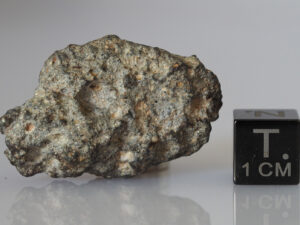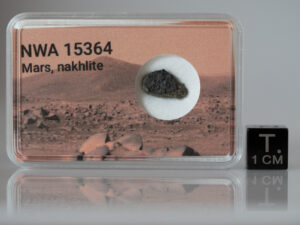Description
NWA 15915 contains exotic sulfides like oldhamite, which is considered to only exist naturally in a narrow region very near the sun at approximately the distance of Mercury’s orbit, and on Mercury itself (source: MetSoc 2024 (LPI Contrib. No. 3036)
Northwest Africa 15915 (NWA 15915)
Algeria
Purchased: 2023 Feb
Classification: Ungrouped achondrite
History: Purportedly found near Aougrout, Algeria. The largest stone was purchased from the finder by Jaouad Chaoui in October 2022, and subsequently cut and sold in two portions to Jay Piatek and Ben Hoefnagels in February 2023. Three additional stones found at the same location were purchased by Mark Lyon in May 2023 from Jaouad Chaoui.
Physical characteristics: The pale yellowish stones (1359, 808, 650, and 26 g) are partially coated with black fusion crust. The very fresh interiors are predominantly beige in color and somewhat friable.
Petrography: (A. Irving, UWS, and J. Boesenberg, BrownU) Coarse grained protogranular aggregate (mean grainsize ~2 mm) composed predominantly of homogeneous, almost pure end-member augite (with sparse, very thin exsolution lamellae of enstatite) accompanied by subordinate discrete grains of enstatite (~ 10 vol.%) and accessory daubreelite, alabandite, troilite, minor low-Ni kamacite and secondary Fe oxide. Olivine and plagioclase are absent.
Geochemistry: Augite (Fs0.0-0.1Wo37.5-43.3, FeO = 0.02-0.08 wt.%, N = 16), enstatite (Fs0.1-0.3Wo0.5-3.2, N = 9). Oxygen isotopes (D. Ibarra, BrownU): analysis of an acid-washed subsample by laser fluorination gave, respectively δ17O 3.369, δ18O 6.470, Δ17O -0.035 per mil (TFL slope value = 0.526).
Classification: Achondrite (ungrouped, Mg-rich clinopyroxenite). These specimens bear some petrologic and isotopic resemblance to Mg-rich websteritic achondrite NWA 13307, but differ in being much richer in clinopyroxene. Although the Δ17O values for both of these Mg-rich specimens are identical, the δ18O value for this specimen is higher by 1 per mil. relative to NWA 13307.
Specimens: 23.8 g including one polished thin section at UWB; portions of the 1359 g main mass are held separately by Mr. J. Piatek (645 g) and Mr. B. Hoefnagels (650 g); other stones of 808 g, 650 g and 26 g are held by Mr. M. Lyon.




